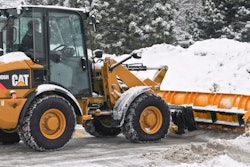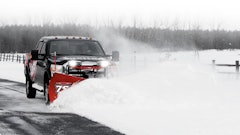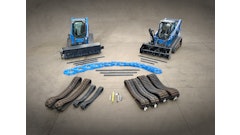
When it’s time to invest in a new snow pusher, contractors should take into account everything from the pusher’s efficiency and application to its components. Doing so impacts your buying decision and long-term ROI.
Randy Strait, owner and president of Arctic Snow & Ice Control and Arctic Snow & Ice Products, says contractors should keep these factors in mind before purchasing.
Product Efficiency & Cost of Ownership
Price point isn’t the most important thing to consider when purchasing a pusher. How much you’ll pay to operate and maintain the pusher over time should also be considered as it can vary greatly from one pusher to the next.
Cost of ownership is often driven by the efficiency of the product so it’s important to ask some questions up front, i.e. “What pusher will give you the best scraping capabilities?” and “What pusher best reduces your cost of doing business?” A pusher that effectively scrapes away snow and ice the first time and keeps the carrier equipment moving rather than creating drag conserves salt and fuel. It also cuts significant outsourcing costs such as hiring extra pick-up plow operators for follow-up snow removal.
Efficiency also includes reducing operator fatigue. If a pusher continually misses snow and ice, the operator might spend twice as long on a job than expected. Long hours and fatigue can lead to costly mistakes and carelessness. This affects a contractor’s safety and could damage the customer’s property or lead to an accident. Look for a pusher that speeds up the process and reduces extra work.
Proper Size
Equipment-mounted pushers, commonly called containment plows or box plows, typically range from 6 feet wide for smaller machines, like skid-steers, up to 30 feet wide for larger equipment, like wheel loaders. Pick a pusher with the proper size and weight for the loader as well as for the application. For example, a compact pusher offers precision on narrow parking lot aisles whereas a larger heavy-duty pusher works better for big open lots.
Quality Components
Certain components impact safety, productivity, and the possibility of equipment and property damage. Make sure to consider all pusher components to see if you’re getting the best bang for your buck.
Moldboard: A one-piece moldboard responds to obstacles by lifting up the entire pusher, requiring additional passes to get what was missed. Segmented moldboards with trip edges better respond to obstacles by lifting only the individual section that comes into contact with the object.
Cutting Edge: Rubber edges wear quickly, lasting only 20% as long as steel. They are also very time-consuming to replace. When steel cutting edges are used on sectional moldboards, 24- to 32-inch sections can be replaced one at a time, simplifying the process, which reduces labor costs and downtime.
Slip Hitch Systems: Hitches that self-adjust to the pavement ensure that all four of the loader’s tires remain on the pavement at all times to retain full traction and eliminate drag and loss of horsepower. These hitches offer inexperienced operators an easy-to-use option and increased productivity since less time is spent adjusting the hitch. Simply drop and go.
Mounting Blocks: Should an operator hit a hidden curb, mounting blocks on the pusher’s mainframe will absorb the impact, protecting the pusher, carrier and operator.
Side Panels: Snow removal companies can spend tens of thousands of dollars each year repairing damage done to curbing and parking lots from fixed side panels. Fixed panels won’t give after the initial contact, and can cause damage to the pusher itself along with the carrier equipment.
Mechanical side panels, on the other hand, lift up and over hidden objects, which minimizes damage and increases operator safety. They allow for complete snow removal at the curb line because they lift up and let the pusher clean right to the curb. The pusher then lifts all the snow up and over the curb leaving nothing behind.
Ultimately, a contractor has to do what is right for his or her business. An inexpensive plow might seem like a good idea until all of the costs add up from having to re-plow, spread salt, perform maintenance and work extra hours. Keep the total cost of business in mind when making purchasing and operation decisions.
![Gravely Pro Turn Mach One My23 Dsc03139 Edit 1200x800 5b2df79[1]](https://img.greenindustrypros.com/mindful/acbm/workspaces/default/uploads/2025/10/gravely-pro-turn-mach-one-my23-dsc03139-edit-1200x800-5b2df791.BucBnDoN22.jpg?auto=format%2Ccompress&fit=crop&h=100&q=70&w=100)

![Kubota Snow ah3 Sgv25ua[1]](https://img.greenindustrypros.com/mindful/acbm/workspaces/default/uploads/2025/10/kubota-snowah3sgv25ua1.bAUoUSziui.png?auto=format%2Ccompress&bg=fff&fill-color=fff&fit=fill&h=100&q=70&w=100)





![Gravely Pro Turn Mach One My23 Dsc03139 Edit 1200x800 5b2df79[1]](https://img.greenindustrypros.com/mindful/acbm/workspaces/default/uploads/2025/10/gravely-pro-turn-mach-one-my23-dsc03139-edit-1200x800-5b2df791.BucBnDoN22.jpg?ar=16%3A9&auto=format%2Ccompress&fit=crop&h=135&q=70&w=240)

![Kubota Snow ah3 Sgv25ua[1]](https://img.greenindustrypros.com/mindful/acbm/workspaces/default/uploads/2025/10/kubota-snowah3sgv25ua1.bAUoUSziui.png?ar=16%3A9&auto=format%2Ccompress&bg=fff&fill-color=fff&fit=fill&h=135&q=70&w=240)








